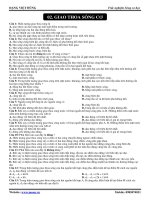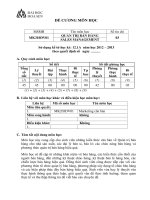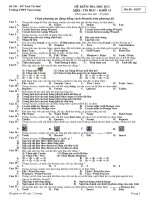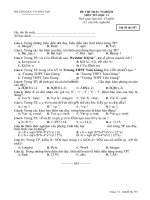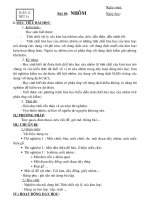CO HANG 3
Bạn đang xem bản rút gọn của tài liệu. Xem và tải ngay bản đầy đủ của tài liệu tại đây (73.07 KB, 4 trang )
<span class='text_page_counter'>(1)</span>SƠN THỊ GANDHI - 7096246 DƯƠNG KIỀU TIÊN - 7096274 NGUYỄN VĂN TRÍ - 7096279. HAMLET I.. Questions for discussion. 1. Analyze Hamlet’s internal conflicts. Recognize his tragedy. Hamlet is a prince of Denmark, he has the internal conflicts. That is the conflict between the obligation of vengeance for his father and the worry about not having enough energy to front the evil influences which occur in the society. The strongest power is the king Claudius who killed Hamlets’ father and also his uncle. Besides, he loses the faith in everyone. They are the courtiers who are greedy and sycophantical. Moreover, his unfaithful mother connived with the king to kill his father. Therefore, he fells so alone and he cannot decide whether to avenge or not. That is the reason why he feels sorrow and says: “to be, or not to be”. These internal conflicts lead to Hamlets’ tragedy that he must live with the hostile (King Claudius who killed his father) and the incestuous mother. 2. What is meant by “to be or not to be?” How is it relevant to Hamlet’s struggle throughout the play? “To be or not to be” means the Hamlets’ confusion. He is trying to decide if he should let go of his anger towards his uncle and mother, or if he should seek revenge. He knows that if he decides to seek revenge that it may result in the end of his life. In the first place, Hamlet doesn’t talk directly about what he’s really talking about. When he questions whether it is better “to be, or not to be,” the obvious implication is, “Should I kill myself?” But at no point does he say that he is in pain or discusses why he wants to kill himself. In fact, he never says “I” or “me” in the entire speech. He’s not trying to “express” himself at all; instead, he poses the question as a matter of philosophical debate. This creates the general impression that there are things going on in Hamlet’s mind that he can’t think about directly. “To be or not to be” is the basic thing to generalize Hamlets’ characteristic. 3. Compare and contrast the characters of Hamlet and Laertes as sons, and as men of action. As sons, Hamlet and Laertes are both dutiful and good sons. They are all want to avenge for their fathers. However, they have different ways in the vengeance. Hamlet has more good strategies but he is alone in vengeance so it is difficult to act. Everybody around him is greedy and sycophantical. All of them are the kings’ lackeys who always keep an eye on Hamlets’ actions. Therefore, it is very difficult for Hamlet to avenge. In contrast, Laertes has circumstances quickly so.
<span class='text_page_counter'>(2)</span> he knows to rely on the king’s power to combat Hamlet. The hatred made Laertes lose his lucidity. That is the reason why he is exploited by the deceitful king. As men of action, the thought of revenge made Hamlet crazy, and made him really reflect on his personality. Is he willing to risk his life for a noble cause like Fortinbras? He calls what he knows into question. On the other hand, the thought of avenging Laertes’ fathers’ death made Laertes forget himself and his normally good nature, and destroyed on kindness toward Hamlet. Revenge truly tore him apart, and when he did kill Hamlet, we do not sure he was satisfied because he felt guilty, especially for cheating by poisoning his sword and attacking when hamlet was not looking. He was guilty because he broke the chivalric code. Revenge made him forget how to play fair, and he may have felt sorry about that in the end. Laertes is a man who reacts to circumstances quickly, with a minimum of reflection on the meaning and possible outcome of his actions, Laertes contrasts sharply with the pensive and indecisive Hamlet and, thus, serves as his foil for the reflective Hamlet 4. Identify the universal themes that are still relevant today. Hamlet provides some insight into modern society, as the play involves many issues which are still very relevant in today world. The key themes behind Hamlet are the price of vengeance, effects of deceit, madness and suicide. The theme most prominent in Hamlet is revenge. Hamlet’s fierce desire to avenge his father’s murder is what drives the play. Modern day society is obsessed with a belief in revenge. In Shakespeare’s Hamlet, the hero is the representation of society and mankind, blinded by a lust for revenge which steers him down the path of evil. Inevitably, this path leads not only to his own death but the death of his family, the woman he loves, and ultimately the destruction of the throne of Denmark. The second theme is deceit. Deception is a large aspect of Hamlet, as every character is very seriously affected by it in one form or another. Hamlet illustrates the dangerous influences that deception can have on relationships and family trust. Nowadays, there are still existences of deceit among the families’ or friends’ relationships. The last theme is madness and suicide. Madness can be a state of mind a person enters when unable, or unwilling, to tolerate real life anymore. In Hamlet, Ophelia turns to madness when she can no longer tolerate the confusion all around her and the turmoil of her own mind. We then see how a person, who is mad or depressed, may begin to contemplate suicide, as a final escape from confusion, as is the case with Ophelia. II. Match the adjectives with the characters’ traits in “Hamlet”. Major characters Hamlet: the prince of Denmark. Adjectives. Explanations. Depressed, desperate, somber, confused. Through Hamlet’s speeches to Ophelia: “To be, or not to be”, “Get thee to a nunnery. I am myself indifferent honest…it were better my mother had not borne me”, “Go.
<span class='text_page_counter'>(3)</span> to,….to a nunnery, go” Claudius: the present king. Deceitful, selfish, ambitious, wicked.. The king killed Hamlet’s father to usurp the throne. He seems concern Hamlet but real life is not. “Madness in great ones must not unwatch’d go”. Gertrude: the queen. Incestuous, weak. She connives with Claudius to kill her husband. “Truly; for their power of beauty will sooner….but now the time gives it proof”’. Polonius: Chamberlain. Pompous, deceptive. Bootlicking lord chamberlain of king Claudius. He relies on his daughter Ophelia to disclose Hamlet. “Ophelia walk you here……the devil himself”. Laertes: Polonius’s son. passive. He only listens to the king Claudius who forces hem to avenge Hamlet. Horatio: Hamlet’s true friend. Loyal, helpful, Trustworth y. Hamlet’s best friend. Horatio never wavers in his loyalty to Hamlet. After Hamlet’s death, Horatio remains alive to tell Hamlet’s story.. Ophelia: Hamlet’ mistress; Polonius’s daughter. Innocent. She loves Hamlet very much. She feels very sorrow when Hamlet becomes madness. “What a noble mind is here o’erthrown!.....to have seen what I have seen, see what I see!”. III. Summary The scene begins with the appearance of the king, the queen and the courtiers in a room of the castle to find out the cause and the treatment for Hamlet (the prince of Demark). First, the king and the queen ask the courtiers about Hamlet’s health. After that, they decide to let Ophelia, who Hamlet used to love very much, meet Hamlet while the king hides himself in a secret place to observe. However, their approach is not effective because Hamlet palavered and something was incomprehensible but we cannot affirm that whether he was like madness. Therefore, the king decides to send Hamlet to the England with the hope that his madness will be recovered. Then, Lord Polonius, one courtier, suggests the queen confide alone to Hamlet to learn about the princes’ afflicted. If the approach of the courtier is not successful, Hamlet will be sent to the England. The end of the scene is the speech of the king about the worry of him to Hamlet..
<span class='text_page_counter'>(4)</span>
<span class='text_page_counter'>(5)</span>
